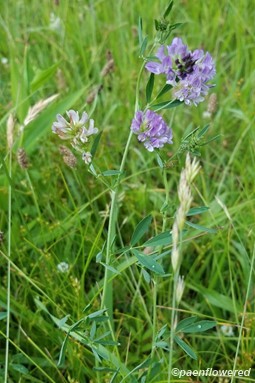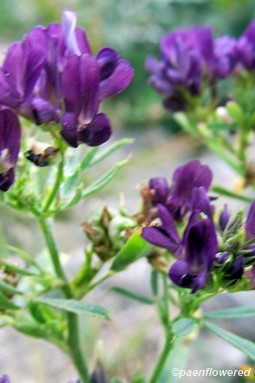Medicago sativa
Medicago sativa alfaalfa
This plant tests the boundary line of what would be considered a wildflower. It is an alien species in the United States, an import from Eurasia. It is also best known as an important forage crop, mostly for cattle and is widely cultivated in many parts of the world. It has been grown as a crop since the 4th century A.D. The plant has four sets of chromosomes (tetraploid) indicating that hybridization and polyploidy was involved in the early history of this species. Those that occur in the wild here are all escapees from farms, though they may reseed in the wild for many generations. They are often found in fields and along roadsides.
Alfalfa is a perennial member of the pea family and is also a legume. This makes it an especially valuable crop because it is able to fix nitrogen from the atmosphere and thus is high in protein. It can grow 1-3 feet high, but is usually a low and prostrate crop with clover-like leaves. The blue to violet flowers are ¼ to ½ inch long and are found in short spikes. It blooms from May to October. Honeybees have some difficulty pollinating alfalfa because the upper lip of the flower smacks them in the head as they try to enter the corolla. They soon tire of this. Therefore the alfalfa leafcutter bee is the primary pollinator.
The fruit is in a spiral shape and contains 10-20 seeds. Alfalfa has a deep roots system and is thus drought resistant. As a crop it is most often cut as hay. The plants can regrow several times after being harvested. It has been used as a medicinal herb and can also be eaten by humans in salads. The common name of the plant is derived from the Arabic term al-Fisfisa, meaning "fresh forage". In Britain it is usually called Lucerne - in France, Luzerne. The Italians emphasize its medical value by calling it Erba Medica.
Habitat & Range
Cultivated and escapes to open areas, such as roadsides, railroads, waste places.
Present throughout the state.
| EMP: | UPL |
|---|---|
| NCNE: | UPL |
Phenology
Flowers May to September.




Comments
Have you spotted this plant in your area? We'd love to hear about your experience! Share your comments or questions about the plant below. Comments are moderated before posting.